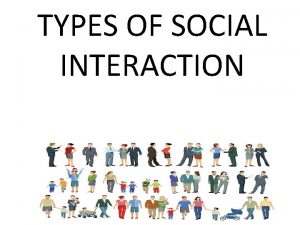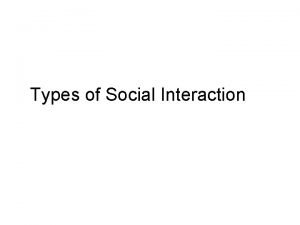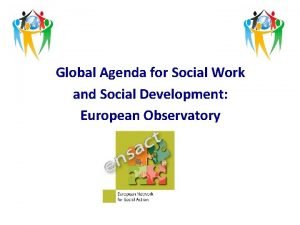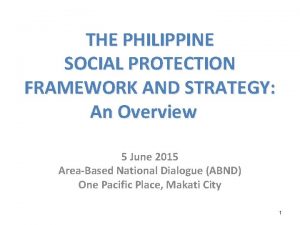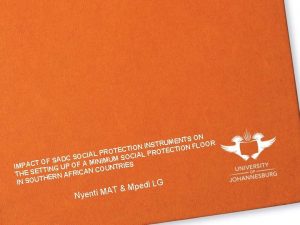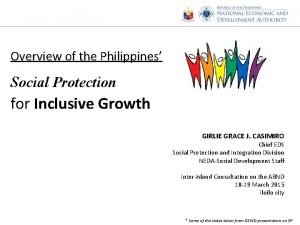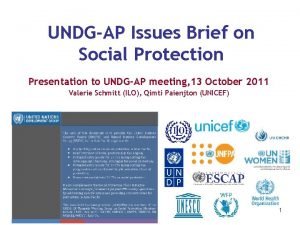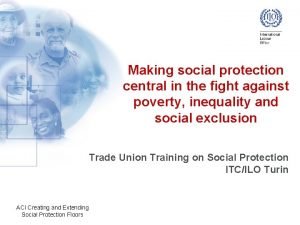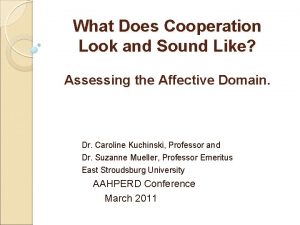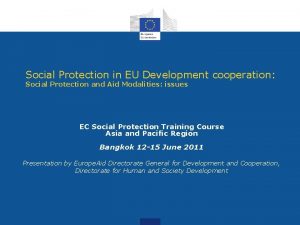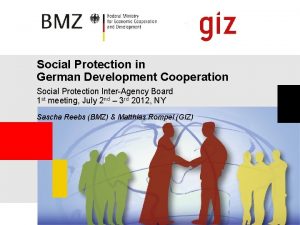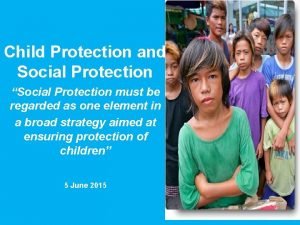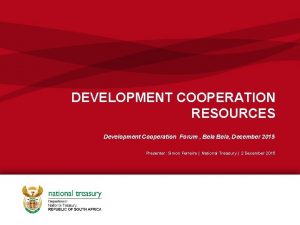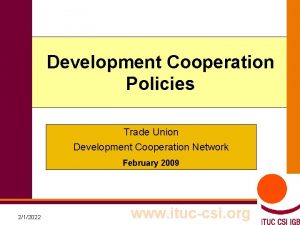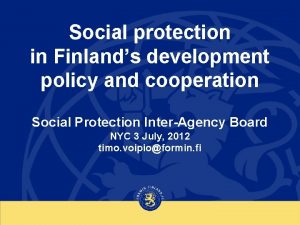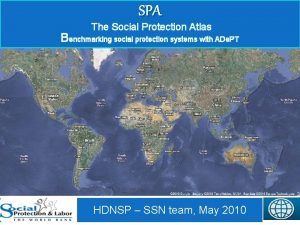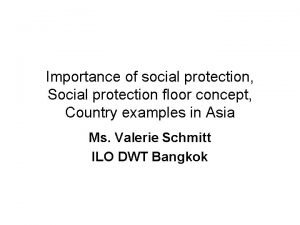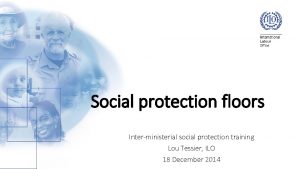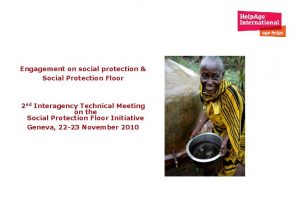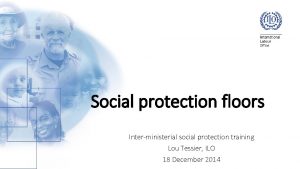Social Protection in EU Development cooperation the new


















- Slides: 18

Social Protection in EU Development cooperation: the new Social Protection Communication and implications for EC work in Asia and the Pacific EC Social Protection Training Course Asia and Pacific Region Bangkok 12 -15 June 2011 Presentation by Europe. Aid Directorate General for Development and Cooperation, Directorate for Human and Society Development

The consultation process (Nov 2011 to March 2012): • Consultation meetings: Member States, civil society, international organisations, partner countries (round tables in Casablanca, Addis Ababa and Bangkok and meetings with Embassies in Brussels). • Online consultation: http: //ec. europa. eu/europeaid/how/publicconsultations/6404_en. htm (Closed: 24 th February 2012)

Responses to online consultation By income level High income Middle income Low income TOTAL Number 96 28 11 135 Share 71% 21% 8% 100% By type of organisation National authority International organisation NGO Academia General Public Other 25 18 50 8 16 18 19% 13% 37% 6% 12% 13% By region Africa Asia & Pacific Europe Latin America & Caribbean Mid East & North Africa North America 12 4 96 17 3 3 9% 3% 71% 13% 2% 2%

Issues paper • Question 4: The European Social model was created for Europe in the mid 20 th century, when full employment in the formal sector was the norm. However, the extensive social security systems characteristic of the European Union Member States are unsuited to the economies of emerging and developing countries, which cannot afford them. • • • Strongly Agree 20% Slightly Agree 21% Slightly Disagree 26. 5% Strongly disagree 28% No opinion 4. 5%

Issues paper • Question 14: Social transfers, including social protection benefits, belong to the recurrent part of national budgets and should not therefore be funded by development partners such as the EU. • • • Strongly Agree 16% Slightly Agree 28% Slightly Disagree 28% Strongly disagree 22% No opinion 6%

Online consultation: Main messages • • Strong support for improving SP & a clear role for EU development cooperation European values, long experience and diverse systems as a basis for EU added value Designed well, SP can raise inclusion, lower poverty & risk without reducing growth But diversity of local conditions rules out template models National priorities & design should dominate Sustainability depends on mix of institutional, political & funding support Low income countries, in particular, face severe constraints

Asia Roundtable: Main messages • SP not just to support growth: Importance of social policy for social cohesion • Design: balance between contributory / non-contributory approaches – need for local adaptation • Affordability: funding models – tax vs debt or aid - & their predictability; institutional preconditions • Employment: relevance of contributory programmes – but challenge of informal sector • Civil society: (a) advocacy & empowerment, (b) improving accountability & (c )service delivery

Asia Roundtable: Main messages (2) • EU role: • 1. European Social Model (inclusion and equity); 2. recognise emerging markets; • 3. align with global initiatives – the SPF; • 4. national priorities dominate; • 5. better donor coordination needed; • 6. EU can help with design / technical assistance

The Communication 1. Why is social protection important? • Persistent poverty and increasing vulnerability. • Social protection in support of inclusive development. • The Agenda for Change: inclusive sustainable growth for human development; focus on sectors which build the foundations of growth and help ensure it is inclusive, notably social protection, health and education. • Calls on the Commission to draft a policy framework.

The communication – Work in progress The purpose of the communication: '…to explain the role of SP in underpinning inclusive and sustainable development and the role of EU dev. Cooperation in supporting the strengthening of social protection policies and systems. '

The communication 2. What is social protection and what can it do? • Broad definition of social protection. • A summary of the ways in which SP supports inclusive economic growth

The communication – Work in progress What is SP and What can it do to support inclusive development? • • • 4 dimensions of SP: Protection instruments [social assistance] • Pension schemes; child protection; food/cash transfers Preventative instruments [insurance] • Insurance schemes; unemployment schemes; livelihood diversification Promotive instruments [productivity enhancing] • Micro-credit; Public Works Programmes; assets transfers Transformative instruments [social justice/Rights Based Approaches] • Minimum wage; maternity benefits; legislation (Source: M. Davies, IDS Centre for Social Protection)

The Communcation 3. SP in The European Union. • SP at the heart of EU social model • The problems EU faces today.

The communication 4. Social Protection in Developing Economies. • In MICs the challenges are to broaden coverage and to improve efficiency. • In LICs funding and institutional capacity are the main constraints. • The common challenge: sustainable financing, extending coverage, building capacity. • Renewed commitment by the international community : the Social Protection Floors Initiative

The Communication 5. The future direction of EU Development Cooperation in support of social protection. “The goal of EU development cooperation in supporting SP is to improve equity and efficiency in provision, while supporting inclusion and social cohesion. ”

The Communication Chapter 5 i) Placing social protection at the centre of dialogue on national development strategies ii) Supporting national policies and programmes iii) Revenue reform for fiscal space iv) Capacity building for strong institutions v) EU Added value in technical cooperation vi) Support for job creation and employment vii) Bring in civil society and the private sector viii) Support for transformative social protection and social justice ix) Gender in social protection

The Communication 6. Development cooperation Programming and modalities. SP may be a focal sector or a dimension in other sector programmes. All aid modalities are relevant. BS can be particularly appropriate. 7. Differentiated development partnerships LICs / MICs 8. Coordinated EU action. Increased coordination at field level. SPF could provide a basis for coordination. 9. Improved coherence among EU policies.

Next steps Adoption by the Commission: August 2012. Council conclusions: October 2012.
 Social interaction cooperation
Social interaction cooperation Example of cooperation in social interaction
Example of cooperation in social interaction Global agenda for social work and social development
Global agenda for social work and social development Social thinking social influence social relations
Social thinking social influence social relations Social thinking social influence social relations
Social thinking social influence social relations Social protection operational framework philippines
Social protection operational framework philippines Social protection instruments
Social protection instruments Social protection operational framework philippines
Social protection operational framework philippines Social protection
Social protection Data protection act in health and social care settings
Data protection act in health and social care settings Ilo social protection
Ilo social protection What does cooperation look like
What does cooperation look like Ilac accreditation
Ilac accreditation Ea european accreditation
Ea european accreditation Cooperation relationship ecosystem
Cooperation relationship ecosystem Cooperation offer
Cooperation offer Interamerican accreditation cooperation
Interamerican accreditation cooperation Asia-pacific economic cooperation forum
Asia-pacific economic cooperation forum This type of work
This type of work
